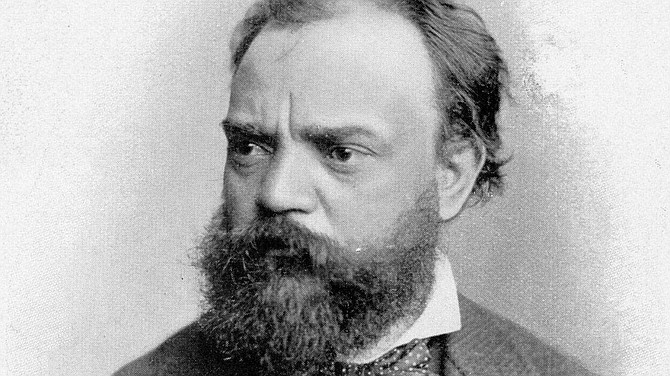 Facebook
Facebook
 X
X
 Instagram
Instagram
 TikTok
TikTok
 Youtube
Youtube

When it comes to symphonies, very few composers have all of their symphonic utterances consistently performed. Of course, Beethoven sits atop the heap even if his First, Second, Fourth, and Eighth symphonies don’t get the adoration received by his Third. Fifth, Sixth, Seventh, and Ninth. Gustav Mahler also gets all of his symphonies regularly performed except for his Seventh. Johannes Brahms gets all four of his symphonies performed on the regular and that about does it. All other composers have half or even fewer of their symphonies performed.
Tchaikovsky’s Fourth, Fifth, and Sixth dominate his First, Second, and Third. Anton Bruckner doesn’t get performed very much but when he does it is usually his Fourth, Seventh, or Eighth. With Jean Sibelius, it’s One, Two, and Five. Franz Schubert is Eight and Nine. Dimitri Shostakovich is Five and Ten. Antonin Dvorak is Seven, Eight, and Nine. Even Mozart is often limited to 29. 35, 40, and 41.
There must be some good symphonies that we are missing. I decided to go find a few.
Felix Mendelssohn wrote five symphonies but only his Fourth gets consistent attention. His Third gets a nod now and then as does his Fifth. Yet, his First symphony, written when he was only 15 years old, is a satisfying symphonic sojourn. It opens with all the energy of youth in the first movement before sinking into a sweet melancholy in the second. The third movement is a charming little dance and the conclusion reaffirms the fires of spring burning in the young romantic’s heart.
Antonin Dvorak’s Symphony No. 5 has all the elements that make him a beloved composer. He makes generous use of Czech folk melodies and rhythms but gives them structure within the symphonic form. The Fifth also expresses Dvorak’s optimistic gloom. Maybe more than any other composer, Dvorak’s music is imbued with melancholic splendor. In the second movement of the Fifth, this ability is fully displayed.
Anton Bruckner’s Symphony No. 3 concludes with what might be the most epic minute-and-a-half of music ever written. The Third opens with a nervous string section while brass gathers themselves for a massive jump-scare about a minute into the music. The slow movement is not the colossus that appears in the Seventh and Eighth Symphonies but it is no slouch. The third movement scherzo has all the energy and drive that we lovers of Bruckner expect and then it’s on to the monstrous final movement.


When it comes to symphonies, very few composers have all of their symphonic utterances consistently performed. Of course, Beethoven sits atop the heap even if his First, Second, Fourth, and Eighth symphonies don’t get the adoration received by his Third. Fifth, Sixth, Seventh, and Ninth. Gustav Mahler also gets all of his symphonies regularly performed except for his Seventh. Johannes Brahms gets all four of his symphonies performed on the regular and that about does it. All other composers have half or even fewer of their symphonies performed.
Tchaikovsky’s Fourth, Fifth, and Sixth dominate his First, Second, and Third. Anton Bruckner doesn’t get performed very much but when he does it is usually his Fourth, Seventh, or Eighth. With Jean Sibelius, it’s One, Two, and Five. Franz Schubert is Eight and Nine. Dimitri Shostakovich is Five and Ten. Antonin Dvorak is Seven, Eight, and Nine. Even Mozart is often limited to 29. 35, 40, and 41.
There must be some good symphonies that we are missing. I decided to go find a few.
Felix Mendelssohn wrote five symphonies but only his Fourth gets consistent attention. His Third gets a nod now and then as does his Fifth. Yet, his First symphony, written when he was only 15 years old, is a satisfying symphonic sojourn. It opens with all the energy of youth in the first movement before sinking into a sweet melancholy in the second. The third movement is a charming little dance and the conclusion reaffirms the fires of spring burning in the young romantic’s heart.
Antonin Dvorak’s Symphony No. 5 has all the elements that make him a beloved composer. He makes generous use of Czech folk melodies and rhythms but gives them structure within the symphonic form. The Fifth also expresses Dvorak’s optimistic gloom. Maybe more than any other composer, Dvorak’s music is imbued with melancholic splendor. In the second movement of the Fifth, this ability is fully displayed.
Anton Bruckner’s Symphony No. 3 concludes with what might be the most epic minute-and-a-half of music ever written. The Third opens with a nervous string section while brass gathers themselves for a massive jump-scare about a minute into the music. The slow movement is not the colossus that appears in the Seventh and Eighth Symphonies but it is no slouch. The third movement scherzo has all the energy and drive that we lovers of Bruckner expect and then it’s on to the monstrous final movement.
Comments